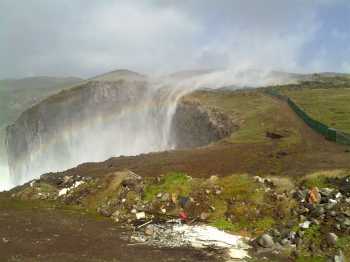The Cory's Shearwater Calonectris diomedea has been identified by ACAP as a potential candidate for listing within the Albatross and Petrel Agreement (click here). The subspecies borealis (sometimes treated as a full species) breeds on the Atlantic Macaronesian islands, including the Portuguese Azores. The westernmost island in the Azores Archipelago, Corvo, supports some 6000 - 10 000 breeding pairs which are threatened by feral and domestic cats Felis silvestris catus and Black rats Rattus rattus.
Corvo (17.5 km²) has a human population living in the single village of Vila do Corvo of around 450 inhabitants. Farming and cattle herding occurs over much of the island.
In the last three years efforts have been made to address the predation problem on Corvo as part of the European Union's LIFE+ Project "Safe Islands for Seabirds". The project aims to restore seabird habitats and increase seabird populations on Corvo and the islet of Vila Franca (off the coast of São Miguel Island) in the Azores. During the four-year period over 2009-2012 the project has been carrying out an alien control feasibility study for both introduced predators and invasive plants. The project's immediate aim is to demonstrate the potential of, and to prepare for, the full restoration of habitats for seabirds on Corvo.
A small area (c. 3.5 ha) near the village was surrounded by a New Zealand-made anti-predator fence last year and 100 artificial burrows within it that were erected the previous year now have both sound and model lures to attract Cory's Shearwaters. It is intended to stock some of these burrows later this year with chicks from elsewhere on the island that will be fed until fledging by island inhabitants, including school children, in the hope that a new colony will become established. Such translocation exercises have proved successful with shearwaters in New Zealand (click here for an example).

Part of the fence enclosure is visible on the right

The shearwater "hotel" of artificial burrow with models made by Corvo's schoolchildren and a solar-powered speaker to play calls

Another view of the shearwater hotel and the anti-predator fence on Corvo in the Azores
All photographs by Steffen Oppel
Last month an International Workshop on Island Natural Restoration was held on Corvo to discuss the conservation of its seabirds, including the Cory's Shearwater. A follow-up story will be posted here once its report becomes available.
The LIFE+ Project "Safe Islands for Seabirds" is coordinated by the Portuguese Society for the Study of Birds (SPEA), the BirdLife International partner in Portugal, along with the Azorean Regional Secretary of the Environment and the Sea (SRAM), the municipal Council of Corvo (CMC) and the United Kingdom's Royal Society for the Protection of Birds (RSPB).
Find out more about the project at http://life-corvo.spea.pt/en/.
Selected reference:
Monteiro, L.R., Ramos, J.A. & Furness, R.W. 1996. Past and present status and conservation of the seabirds breeding in the Azores Archipelago. Biological Conservation 78: 319-328.
With thanks to Steffen Oppel for information and photographs.
John Cooper, ACAP Information Officer, 18 June 2012

 English
English  Français
Français  Español
Español